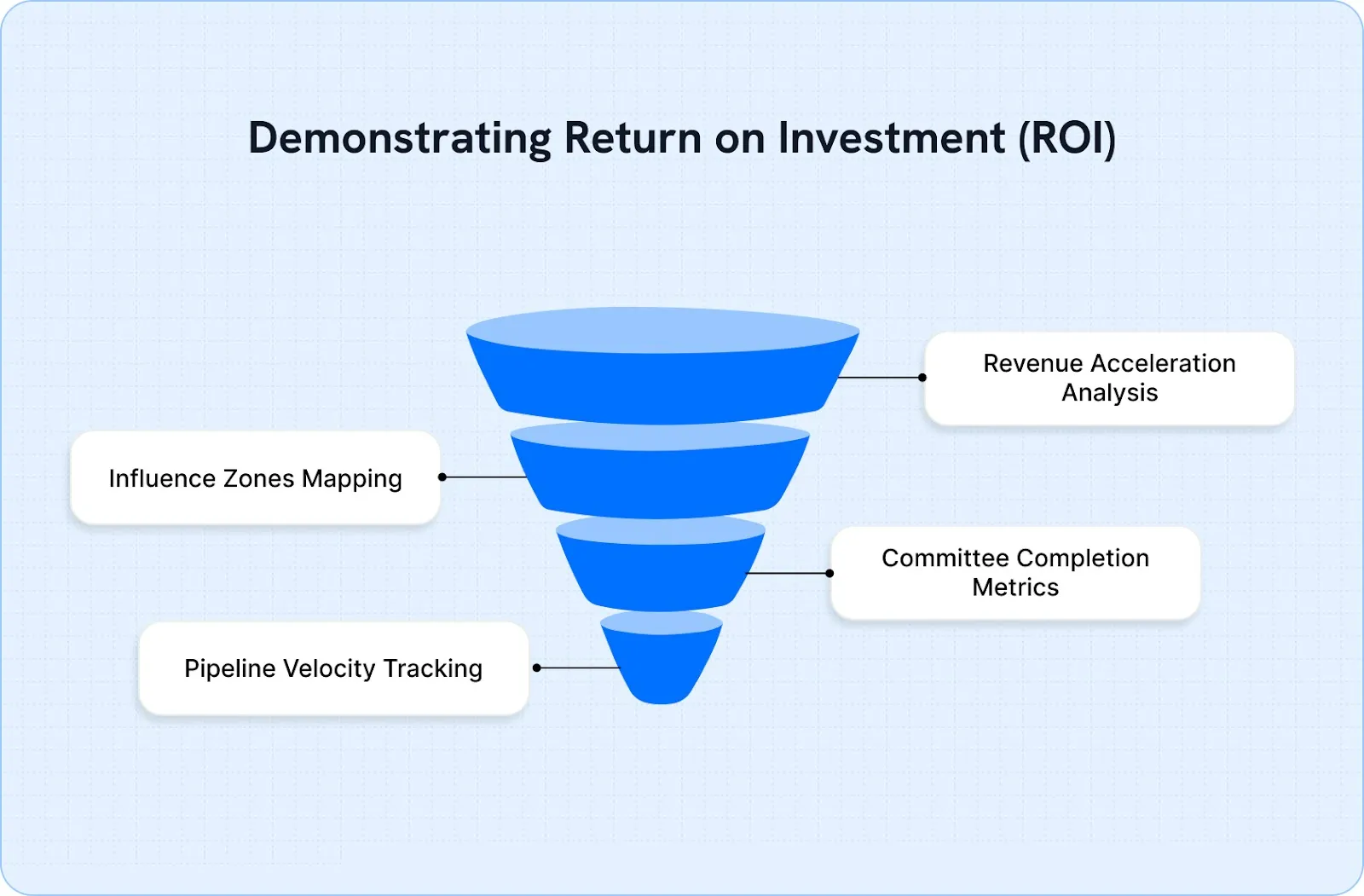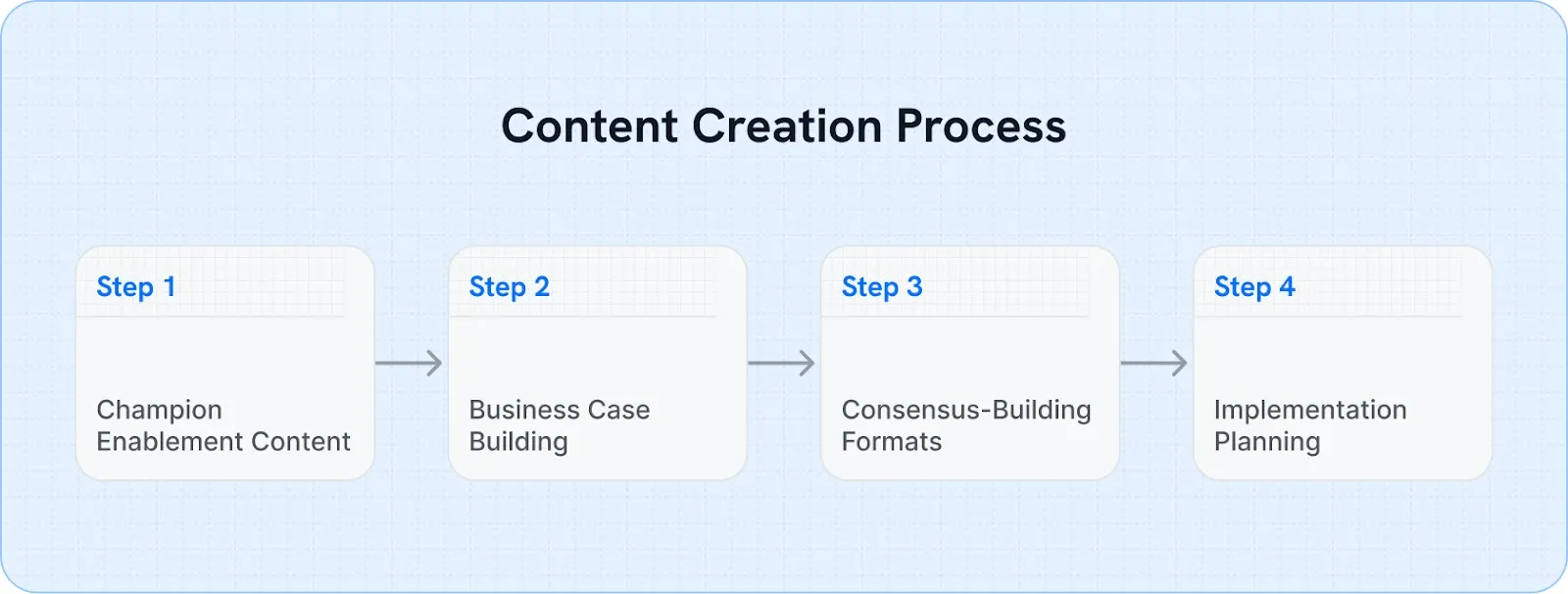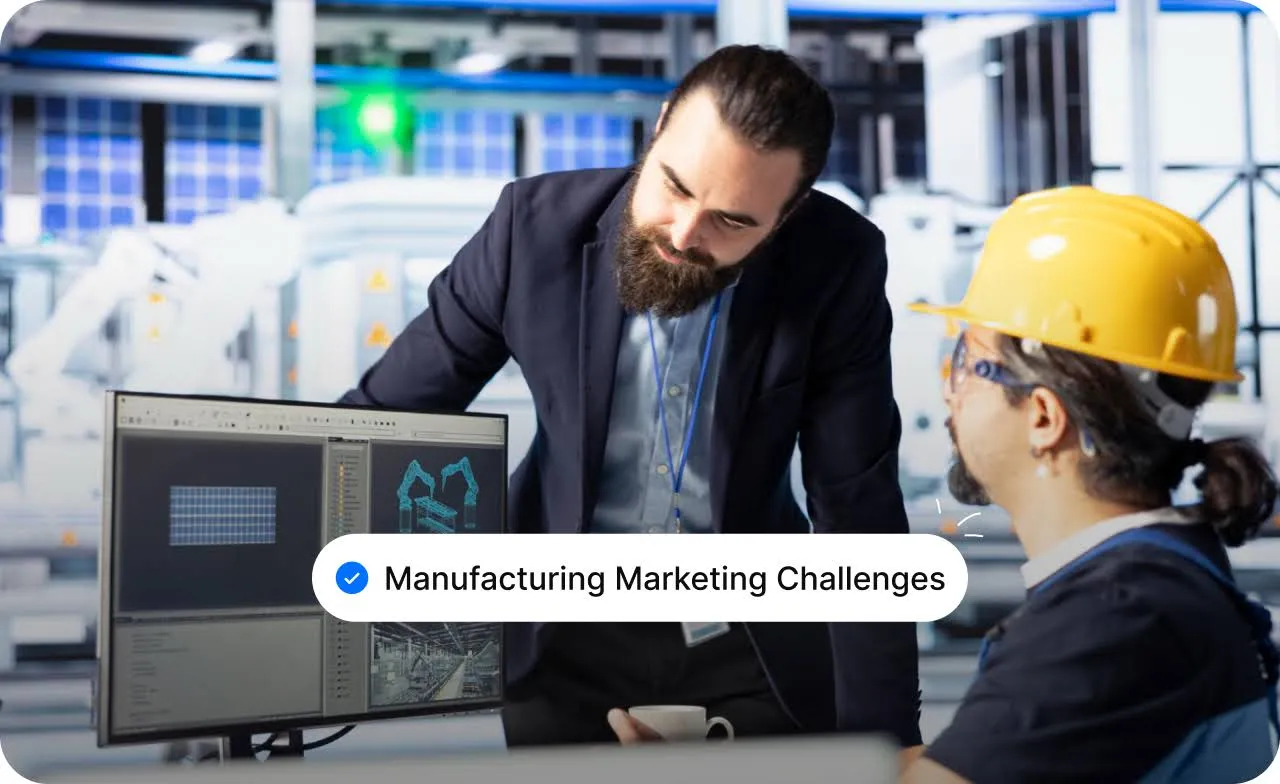Most manufacturers know how to run a factory like clockwork. They understand efficiency, precision, and output. But when it comes to marketing, things start to feel unpredictable.
That frustration isn’t random. It’s the result of a few common challenges that manufacturers face when they try to take marketing online. Unlike retail, your buyers don’t make emotional purchases.
What you need isn’t “more marketing.” You need clarity, a system that speaks to engineers, procurement teams, and B2B buyers in their language.
This guide breaks down the real blockers in your marketing and shows you how to track the right results, attract serious buyers, create content that supports their decisions, and use smart tools to strengthen relationships and drive consistent growth.
What Do We Mean by Manufacturing Marketing Challenges?
When people hear “marketing,” they often think of ads, social media, or fancy brochures. But in manufacturing, marketing looks very different. It’s about helping the right buyers discover your company and trust it enough to reach out.
A manufacturing marketing challenge is simply anything that gets in the way of that. It’s what stops your business from getting consistent, qualified inquiries even though your setup, pricing, and quality are solid.
Here’s what that usually looks like in real life:
1. Your website doesn’t explain what you actually make.
Most manufacturing sites list product names or categories but skip details like materials, grades, or applications. Buyers looking for a specific item can’t tell if you can make it, so they move on.
2. You’re visible offline but invisible online.
You might be well-known in your region or within your network, but outside that circle, no one can find you. When buyers search on Google, they see competitors instead of you.
3. You get the wrong kind of inquiries.
Students, small resellers, or low-quantity buyers keep reaching out because your content doesn’t speak to the right audience. The real buyers don’t realize you’re a good fit.
4. You rely on trade shows or word of mouth.
Those channels work, but they’re unpredictable. One canceled event or slow quarter, and your pipeline goes quiet.
5. You think marketing is “not for manufacturing.”
That’s one of the biggest challenges. Marketing is about showing the people who already need your product that you exist and are capable of delivering.
In short, marketing is not about competition or product quality. It solely advocates for communication, how clearly your business explains what it does, who it helps, and why buyers should trust you.
Challenge 1: Demonstrating Return on Investment (ROI)

Manufacturers, your sales cycles are long, approx 130 days as per research by Focus Digital. With multiple decision-makers involved, traditional marketing metrics like "last-touch attribution" or "lead volume" often miss the mark. These methods either overvalue the final contact point or ignore the extended nurturing process that builds trust and interest over time.
The real issue? You're focusing on isolated touchpoints instead of the entire customer journey.
What Actually Works:
- Pipeline Velocity Tracking: Measure how marketing accelerates the movement of prospects through the sales stages.
- Committee Completion Metrics: Track how many stakeholders engage before the sales handoff.
- Influence Zones Mapping: Assign value to activities at each stage—awareness, consideration, evaluation, and consensus-building.
- Revenue Acceleration Analysis: Compare deal size and close rates for marketing-influenced versus cold opportunities.
Practical Steps:
- Replace counting Marketing Qualified Leads (MQLs) with measuring lead velocity.
- Analyze the correlation between deal size and the depth of marketing engagement.
- Implement attribution windows that align with your actual sales cycles.
- Develop dashboards that showcase pipeline health, not just lead volume.
By adopting these strategies, you can gain a clearer understanding of how your marketing efforts contribute to long-term sales, moving beyond traditional metrics to a more comprehensive view of ROI.
Challenge 2: Generating High-Quality Leads
Manufacturers often focus on volume when it comes to lead generation, but in reality, it's about relationship-building with the right decision-makers. The issue? Your "leads" are actually entire buying committees, each at different stages of the decision-making process.
The CMO Survey reports that optimism among manufacturing marketers in the U.S. economy has climbed into the mid-60s on a scale of 1 to 100.
What Actually Works:
- Account-Based Targeting: Focus on companies, not just individuals, to better understand their needs as a whole.
- Committee Mapping: Engage with all stakeholders involved in the buying decision, not just the first contact.
- Progressive Profiling: Gradually gather more insights on the buying process to tailor your approach.
- Intent Signal Tracking: Monitor research behaviors that indicate active projects and serious interest.
Practical Implementation:
- Account-Level Engagement Scoring: Track engagement at the company level, not just individual leads.
- Role-Specific Nurture Tracks: Customize messaging for different stakeholders (engineers, finance, procurement).
- Stakeholder Identification Content: Offer tools like org charts to help identify decision-makers.
- Buying Committee Tracking: Ensure all stakeholders are engaged before sales handoff.
Focusing on the full buying committee and understanding their journey will help generate high-quality leads ready to convert.
Challenge 3: Reaching Your Target Audience
Many manufacturers struggle with reaching their target audience because they’re using B2C strategies that don’t fit the B2B industrial market. The truth is, manufacturing buyers don’t browse social media looking for equipment; they’re searching for technical details and relying on trusted networks for recommendations.
What Actually Works:
- Technical Content SEO: Focus on solving problems through content, not just product listings. Optimize for the specific searches buyers are making.
- Industry Publication Partnerships: Get your message in front of buyers where they already go for information, industry publications and specialized websites.
- Trade Show Digital Integration: Take conversations from trade shows and keep them going digitally throughout the year to maintain engagement.
- Referral Network Activation: Use your existing customers to introduce you to potential leads; trusted referrals go a long way.
Practical Implementation:
- Audit Traffic Sources: Shift budget from low-performing channels like social media to high-performing search and industry-specific websites.
- Create Technical Resource Libraries: Develop content that answers solution-based queries, not just product-focused ones, to drive organic traffic.
- Account-Based Advertising: Target specific companies and decision-makers with tailored ads that speak to their exact needs.
Customer Advocacy Programs: Develop programs that encourage referrals and case studies from satisfied customers to build trust.

By focusing on the channels and messaging that align with how industrial buyers research and make decisions, you'll be able to reach the right audience and engage them effectively.
Challenge 4: Not Creating Engaging Content

Many manufacturers make the mistake of creating content that only appeals to technical experts, people who already understand their technology. But the real need is content that helps the entire buying committee make a decision.
Technical buyers aren’t looking for more education; they need content that arms them with the tools to convince their colleagues and get internal buy-in.
What Actually Works:
- Champion Enablement Content: Create resources that empower technical buyers to educate their teams internally.
- Business Case Building: Provide tools like ROI calculators, cost comparisons, and risk assessments to help decision-makers justify the purchase.
- Consensus-Building Formats: Design content that multiple stakeholders can engage with and discuss together.
- Implementation Planning: Outline clear steps from purchase to results, showing how your solution delivers on its promises.
Practical Implementation:
- Convert Technical Specs into Business Impact Stories: Focus on how your product solves business problems, not just on its features.
- Create Presentation Templates for Champions: Provide easy-to-use templates that buyers can use to present your solution internally.
- Develop Executive Summaries: Condense complex technical content into digestible executive summaries for higher-level decision-makers.
- Build Decision-Making Frameworks: Offer frameworks that help guide the discussions within the buying committee and move them toward a consensus.
Challenge 5: Keeping Up with Digital Marketing Trends
It’s easy to get caught up in the latest digital marketing trends, but for manufacturers, success comes from deep industry expertise, not simply following what's trending. The issue is that many of these trends are designed for different business models and buyer behaviors, which makes them ineffective for the unique needs of the manufacturing industry.
What Actually Works:
- Manufacturing-Specific Innovation: Rather than blindly adopting trends, tailor them to suit the behaviors and preferences of industrial buyers.
- Process Innovation Over Tactical Innovation: Focus on improving how you create and distribute content, rather than just jumping on the latest platforms.
- Technology That Amplifies Expertise: Leverage AI and automation to scale the knowledge of your subject matter experts, making it accessible to more potential buyers.
- Long-Term Relationship Building: Invest in systems that support lengthy buyer journeys, especially when decisions can take 18 months or more.
Practical Implementation:
- Evaluate Trends Through the Lens of Manufacturing Buyer Behavior: Assess new trends by considering how they align with your specific buyers’ needs, not just general market shifts.
- Focus on Technology Investments That Scale Expertise: Prioritize investments in AI and automation tools that can capture and scale the insights of your internal experts.
- Build Systems for Long-Term Relationship Building: Design systems that nurture leads over an extended period, offering value at each stage of their 18-month journey.
Prioritize Compounding Improvements: Look for opportunities to improve systems that build on past successes, creating a snowball effect over time.

Adapting trends to fit the unique needs of the manufacturing industry will help you maintain a sustainable, long-term strategy rather than chasing fleeting digital fads. By focusing on process improvements and using technology to scale expertise, you’ll build deeper, more meaningful relationships with buyers.
Real Talk: Manufacturing Marketing Wins You Can Learn From
As a manufacturer, it's easy to feel overwhelmed by all the marketing options out there. But the truth is, the best results come from focusing on the basics, optimizing for the right audience, and using channels that actually work.
Let's take a look at a real-world example that shows how manufacturers can make digital marketing work for them.
SEO Success: How Pazago Boosted Leads (and Confidence)
Pazago, a leading logistics and digital freight forwarding platform, made smart moves with SEO, resulting in a significant increase in inbound leads. By focusing on technical SEO, content optimization, and local search, they were able to attract the right audience, driving relevant traffic to their site.
Key Actions:
- Technical SEO: Pazago improved site speed and mobile optimization, ensuring a better experience for visitors and better performance on search engines.
- Local SEO: They personalized their SEO efforts to target businesses in specific regions, capturing leads in key markets.
- Content Optimization: Pazago created content that spoke directly to their target market’s pain points, like guides on cross-border logistics and digital freight forwarding, making sure it was relevant and valuable.
Results:
- 30% Increase in Inbound Leads: In just 6 months, they saw a 30% jump in inbound leads, proving that SEO can drive real business results.
- Higher Search Engine Rankings: Pazago climbed higher for key logistics-related keywords, boosting visibility.
- Qualified Traffic: More visitors from their target regions, ready to engage with their services.
Takeaway: SEO isn’t just about keywords; it’s about creating a website that answers your customers' needs. By focusing on practical content that addresses specific pain points and improving site performance, Pazago increased both its lead generation and its online visibility.
Key Takeaways: From Challenges to Celebrations
Thriving in today’s manufacturing world means embracing digital marketing strategies that are personalized to your specific needs.
It’s no longer enough to rely on traditional methods; success lies in creating content that speaks directly to your audience, automating repetitive tasks to boost efficiency, and leveraging new technologies like AI to stay competitive.
By making these shifts, you can overcome challenges and celebrate the growth that follows.
Gushwork specializes in helping manufacturers streamline their marketing efforts, from content optimization to AI-driven automation.
With our personalized strategies, you can focus on what matters most: growing your business and connecting with the right customers.
Let's discuss how we can help you take your marketing to the next level!
FAQs
Q1. How can I measure ROI accurately in manufacturing marketing?
A1. To measure ROI effectively, focus on the entire buyer journey with methods like Pipeline Velocity Tracking, Committee Completion Metrics, and long-term attribution windows to understand the impact of each marketing touchpoint.
Q2. What is the most effective way to generate high-quality leads in manufacturing?
A2. Focus on account-based targeting and engage all stakeholders in the buying process with committee mapping. Tailor content to meet the needs of each role within the buying committee.
Q3. Why is SEO important for manufacturing companies?
A3. SEO helps you get noticed by buyers who are searching for technical solutions. Optimizing your website for solution-focused content ensures you attract relevant traffic and qualified leads.
Q4. How can content marketing be more effective for manufacturing companies?
A4. Shift from educating experts to creating content that supports decision-makers in the buying committee, such as business case tools, ROI calculators, and implementation guides that help them justify the purchase internally.
Q5. How do I reach my target audience if they aren't browsing social media?
A5. Focus on technical content SEO, leverage industry publications, and integrate trade show conversations digitally to engage buyers in the right places, where they already seek solutions.
Q6. How can AI improve marketing efforts in manufacturing?
A6. AI can automate repetitive tasks, scale subject matter expertise, and improve content personalization, ultimately helping manufacturers engage more effectively with their audience and optimize their marketing strategies.




















.webp)








.webp)
.svg)


.svg)
.svg)
.svg)







.svg)